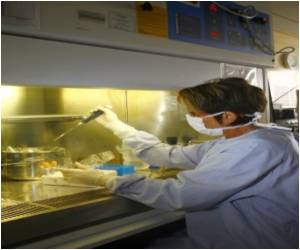
Small interfering RNAs as specific antiviral weapons
The researchers infected mouse embryonic stem cells with two viruses, the encephalomyocarditis virus (EMCV) and the Nodamura virus (NoV). Subsequently, they were able to detect short RNA molecules of about 22 nucleotides in length within the cells. The sequence of these RNA clearly corresponded to the viral genome and they displayed all the characteristics of the main effector molecules of RNAi called the small interfering or siRNAs. This provided evidence that the virus infection had activated the RNAi machinery of mammalian cells.
The trigger for RNAi is an unusual RNA molecule that arises when the viral genome is copied: a long, double-stranded RNA molecule. This double-stranded RNA is cut into shorter pieces to produce siRNAs, which subsequently serve as a homing device. Since they are derived from the viral RNA and thus correspond perfectly to its sequence, they guide molecular scissor proteins to the viral RNA. The latter is subsequently cut into harmless pieces. Thus, the virus can no longer proliferate.
Ideal protection for progenitor cells
Voinnet provides two reasons why the role of RNAi in antiviral immunity in mammals has been overlooked for so long: first, studies conducted in plants (notably by the Voinnet group) and later in invertebrates have shown that many viruses have developed counter-defences to inhibit the RNAi machinery of infected cells. If such counter-defences existed also in mammalian viruses, they would likely mask antiviral RNAi. Second, most scientists have looked for antiviral RNAi in differentiated cells in which the interferon response makes up the majority of the innate immune response. In contrast, Voinnet and his colleagues have focused on stem cells.
Advertisement
"Beauty in simplicity"
Advertisement
Work conducted in parallel and published back-to-back by Voinnet's colleague and collaborator Shou Wei Ding (University of Riverside, USA) show that siRNAs could be also detected in tissues of newborn mice infected with the modified NoV. Remarkably these siRNAs were identical to those found by Voinnet and colleagues in cultured mouse stem cells and they provided the suckling mice a near-complete immunity against the virus. "This was important proof to show that antiviral RNAi exists in a living organism and not just in stem cell cultures," explains Voinnet.
Thus, the researchers have revealed an important and so far hidden part of innate immunity in mammals. "The beauty of this system is its simplicity, and, we can now say it, its universality," says Voinnet. "The RNAi machinery is part of the cells' normal life, but it acquires its function as an antiviral weapon thanks to the RNA that is produced by the virus to be eliminated. Since the specificity of the response is provided by the virus itself, the mechanism can basically adapt to any virus. Immunity could not be more innate than that!" he concludes.
Source-Eurekalert









